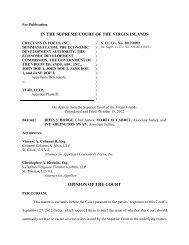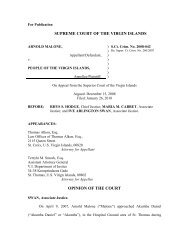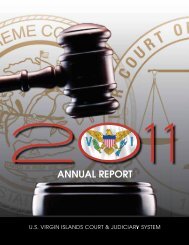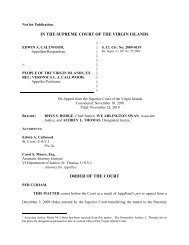IN THE SUPREME COURT OF THE VIRGIN ISLANDS OPINION OF ...
IN THE SUPREME COURT OF THE VIRGIN ISLANDS OPINION OF ...
IN THE SUPREME COURT OF THE VIRGIN ISLANDS OPINION OF ...
You also want an ePaper? Increase the reach of your titles
YUMPU automatically turns print PDFs into web optimized ePapers that Google loves.
For Publication<strong>IN</strong> <strong>THE</strong> <strong>SUPREME</strong> <strong>COURT</strong> <strong>OF</strong> <strong>THE</strong> VIRG<strong>IN</strong> <strong>ISLANDS</strong>ALLENTON BROWNE,Appellant/Defendant,v.LAURA L.Y. GORE,Appellee/Plaintiff.)))))))))S. Ct. Civ. No. 2011-0012Re: Super. Ct. Civ. No. 155/2010 (STX)On Appeal from the Superior Court of the Virgin IslandsConsidered: November 2, 2011Filed: September 19, 2012BEFORE:RHYS S. HODGE, Chief Justice; MARIA M. CABRET, Associate Justice; andIVE ARL<strong>IN</strong>GTON SWAN, Associate Justice.APPEARANCES:Natalie B. Nelson Tang How, Esq.Law Office of Natalie Nelson, P.C.St. Croix, U.S.V.I.Attorney for AppellantLaura L.Y. GoreLithonia, GeorgiaPro SeCABRET, Associate Justice.OP<strong>IN</strong>ION <strong>OF</strong> <strong>THE</strong> <strong>COURT</strong>Allenton Browne appeals from a January 28, 2011 Opinion and Order issued by aSuperior Court judge, which affirmed a judgment entered by a Superior Court magistratedirecting Browne to vacate No. 85 Catherine Rest, St. Croix, for failure to pay rent. For thereasons that follow, we reverse the January 28, 2011 Opinion and Order and remand the matterto the Superior Court for proper compliance with Superior Court Rule 322.
Browne v. GoreS. Ct. Civ. No. 2011-0012Opinion of the CourtPage 2 of 10I. FACTUAL AND PROCEDURAL BACKGROUNDOn April 9, 2010, Laura L.Y. Gore, a resident of Georgia, filed a pro se forcible entryand detainer (“FED”) complaint against Browne, which alleged that Browne had been living atNo. 85 Catherine’s Rest for approximately thirteen years, but “has habitually been late in makingmonthly payments” and ultimately failed to pay the full rent due for January, February, andMarch 2010. (J.A. 71.) The Superior Court assigned the matter to a Superior Court magistrate,see 4 V.I.C. § 123(a)(6), who ultimately scheduled a hearing for July 20, 2010. When Brownefailed to attend that hearing, the magistrate entered a default judgment against him and orderedhis eviction.In addition to her FED action, Gore had filed a small claims complaint against Browne,which had been assigned to the same magistrate, see 4 V.I.C. § 123(a)(4), who scheduled ahearing for July 21, 2010. This time, Browne attended the hearing, but—like Gore—appearedpro se due to the prohibition on attorneys representing litigants in small claims proceedings. See4 V.I.C. § 112(d). At the start of this hearing, the magistrate advised Browne that a hearing onGore’s FED complaint had been held the prior day and a default judgment entered against him.Browne responded that he had been present at the courthouse at the time of the July 20, 2010hearing, and asked the magistrate to re-open the FED case so he could contest the FEDcomplaint on the merits. When Gore objected because she had booked a flight to leave St. Croixon July 24, 2010, the magistrate stated that she would first conduct the small claims hearing asscheduled, and then hold a new FED hearing later that afternoon.Browne objected to this procedure because he wished to have his retained counselintroduce evidence and make arguments on his behalf during the FED hearing. The magistrate,however, found that Browne was “trying to unnecessarily prolong this matter” and would not
Browne v. GoreS. Ct. Civ. No. 2011-0012Opinion of the CourtPage 3 of 10allow a continuance for Browne to appear through retained counsel because “[Gore] doesn’t livehere” and Browne had the opportunity to appear through counsel at the July 20, 2010 hearing,but neither he nor his counsel were present. (J.A. 45-46.) When Browne asked for a continuanceon the grounds that he could not proceed because he was not prepared to contest the FED matterthat day, the magistrate replied that Browne should have been prepared to address the FEDcomplaint the prior day. Finally, the magistrate informed Browne that if he did not appear thatafternoon to address the FED complaint, the default judgment issued the prior day would stand.The magistrate held a hearing on Gore’s FED complaint that afternoon, with both partiesappearing pro se. The following day, the magistrate entered judgment in favor of Gore anddirected Browne to immediately vacate No. 85 Catherine’s Rest. On July 27, 2010, Browne,through his retained counsel, filed a motion for stay of execution on the grounds that themagistrate lacked jurisdiction over the FED complaint because Browne and Gore had allegedlyentered into a mutual agreement for the purchase and sale of the property, and thus were nolonger in a landlord/tenant relationship. Browne also filed a motion for reconsideration onAugust 2, 2010, which set forth this same argument as grounds for vacating the judgment. In anAugust 3, 2010 Order, the magistrate denied the motion for stay of execution on the grounds thatBrowne’s “claim [that] the parties entered into a purchase/sell arrangement was disputed by[Gore] when this matter came on for a hearing,” and that “[t]he Court found [Gore]’s testimonyto be more credible than that of [Browne], and pointed out that any oral agreement would besubject to the doctrine of the applicable statute of frauds.” (J.A. 99.)Even though the magistrate had not yet ruled on his motion for reconsideration, Browne
Browne v. GoreS. Ct. Civ. No. 2011-0012Opinion of the CourtPage 4 of 10filed a “notice of appeal” of the magistrate’s decision on August 5, 2010, 1 which was construedas a petition for internal review of a magistrate decision pursuant to the Interim Procedures forSeeking Review of Magistrate Determinations (“Interim Rules”), adopted by the Presiding Judgeof the Superior Court in a December 31, 2009 Order. See In re: Order Establishing InterimProcedure for Review of Magistrate Decisions, Super. Ct. Civ. No. Misc. No. 30/2009, slip op. at1-2 (V.I. Super. Ct. Dec. 31, 2009). However, the Interim Rules simply established a limitationsperiod and a filing fee, and were silent as to how the parties should proceed with briefing orotherwise prosecuting the matter.While Browne’s petition for internal review remained pending, the Presiding Judge, in aNovember 23, 2010 Order, promulgated Superior Court Rule 322, which governs internal reviewof magistrate decisions by the Superior Court. The November 23, 2010 Order expresslyprovided that “[t]his amendment is effective immediately and supersedes the Interim Rulespreviously established in Super. Ct. Misc. 30/2009.” In re: Order Amending the RulesGoverning Review of Magistrate Decisions, Super. Ct. Misc. No. 30/2010 (STX), slip op. at 1(V.I. Super. Ct. Nov. 23, 2010). Pursuant to Rule 322, a Superior Court judge shall not rule on apetition for internal review until “the filing of: the opening brief of the petitioner, the responsivebrief of the respondent, filing of a certified transcript of the proceedings, . . . the resolution of allmotions filed, payment of all required fees, and satisfaction of the appeal or supersedeas bond, ifany.” SUPER. CT. R. 322.1(h)(2)(F). Moreover, Rule 322 provides that “the Clerk shall issuenotice to the parties regarding the schedule and deadlines for: completion of the record,1 In the January 28, 2011 Opinion, the Superior Court judge stated that he would consider the matternotwithstanding the absence of a ruling on Browne’s motion for reconsideration because the August 3, 2010 Orderdenying the motion for stay of execution had considered the same issues raised in the reconsideration motion. (J.A.14 n.6.)
Browne v. GoreS. Ct. Civ. No. 2011-0012Opinion of the CourtPage 5 of 10completion of briefing, payment of docketing fees, request and payment of transcripts,” SUPER.CT. R. 322.1(i)(A), provided, however, that the “trial judge may, by order, waive the need forbriefs or excuse any party from filing briefs without adverse action if the issue presented forreview is an issue of law which has previously been determined by controlling law and for whichthere is no reasonable dispute, and the issues may be determined based on the case record.”SUPER. CT. R. 322.1(i)(B).Notwithstanding Rule 322, the Superior Court judge assigned to consider Browne’spetition issued a January 28, 2011 Opinion and Order adjudicating the merits of the matter, eventhough the parties had not submitted briefs, the Clerk of the Superior Court had not issued abriefing schedule, and the judge never notified the parties that the matter would be considered onthe record without briefs. See Browne v. Gore, 54 V.I. 195 (V.I. Super. Ct. 2011). Ultimately,the Superior Court judge held that the magistrate “properly retained jurisdiction over this matteras an FED proceeding,” and affirmed the July 22, 2010 Order. Id. at 209. Browne timely filedhis notice of appeal to this Court on February 11, 2011.II. DISCUSSIONA. Jurisdiction and Standard of ReviewWe have jurisdiction over this civil appeal pursuant to title 4, section 32(a) of the VirginIslands Code, which provides that “[t]he Supreme Court shall have jurisdiction over all appealsarising from final judgments, final decrees or final orders of the Superior Court, or as otherwiseprovided by law.” 4 V.I.C. § 32(a). “An order from the Superior Court affirming a magistrate’sfinal [judgment] in an FED action is a final order appealable to this Court under section 32(a).”Lehtonen v. Payne, S. Ct. Civ. No. 2011-0065, 2012 WL 3181348, at *2 (V.I. Aug. 1, 2012)(citing H&H Avionics, Inc. v. V.I. Port. Auth., 52 V.I. 458, 461-63 (V.I. 2009)).
Browne v. GoreS. Ct. Civ. No. 2011-0012Opinion of the CourtPage 6 of 10The standard of review for this Court’s examination of the Superior Court’s applicationof law is plenary, while the Superior Court’s findings of fact are reviewed for clear error. St.Thomas-St. John Bd. of Elections v. Daniel, 49 V.I. 322, 329 (V.I. 2007).B. Superior Court Rule 322On appeal, Browne contends that the Superior Court judge violated his procedural dueprocess rights by adjudicating his petition for internal review on the merits in the absence of abriefing schedule. Specifically, Browne argues that Superior Court Rule 322 applied to hispetition, and that Rule 322 sets forth specific requirements related to briefing and considerationof petitions that were not followed in this case. In her pro se brief, Gore acknowledges that Rule322 governed Browne’s petition, but requests that this Court affirm the January 28, 2011Opinion because (1) Rule 322 does not require the submission of briefs, (2) Browne failed totake the steps necessary to prosecute his petition, and (3) Browne could have filed a brief butfailed to do so.We agree with the parties that Rule 322 unquestionably applied to Browne’s appeal.Even though the Superior Court promulgated Rule 322 after Browne filed his petition for review,the November 23, 2010 Order adopting Rule 322 expressly states that “[t]his amendment iseffective immediately and supersedes the Interim Rules previously established in Super. Ct.Misc. 30/2009.” Even in the absence of this explicit language, it is well established thatamendments to procedural rules apply to all cases pending at the time of the rule change. See,e.g., Fontaine v. People, 56 V.I. 571, 592 n.16 (V.I. 2012) (noting that, on remand, priorevidentiary rulings decided under the Uniform Rules of Evidence should be reconsidered in lightof the subsequent adoption of the Federal Rules of Evidence); Ferdinand v. Bureau ofCorrections, S. Ct. Civ. No. 2008-0059, 2011 WL 3490192, at *1 (V.I. July 19, 2011)
Browne v. GoreS. Ct. Civ. No. 2011-0012Opinion of the CourtPage 7 of 10(unpublished) (permitting habeas corpus appeal to proceed, despite denial of certificate ofprobable cause, when court rule subsequently amended to eliminate certificate of probable causerequirement). Therefore, the Superior Court judge committed error to the extent he issued theJanuary 28, 2011 Opinion and Order based on a belief that the Rule 322 procedure did notapply. 2 We also find that Gore’s arguments seeking to excuse the Superior Court judge’s failureto comply with Rule 322 lack merit. While it is true that Rule 322 does not require submissionof briefs in all circumstances—in that Rule 322.1(i)(B) allows a judge to issue an order waivingbriefing in a particular case—this exception is not applicable to this case, for the judge never2 Although not expressly addressed by the parties, we note that the text of the January 28, 2011 Opinion containssome indication that the Superior Court judge may have incorrectly believed that Browne had actually filed a brief.First, the opinion contains several references to the parties raising or not raising certain issues and arguments onappeal, which is impossible to reconcile with the fact that neither party actually filed a brief. See, e.g., 54 V.I. at 198(“Browne argues on appeal that the Magistrate erred in granting the writ . . . .”); 200 n.4 (“Browne has notchallenged on appeal the adequacy of the notices.”); 204 (“Browne disputed receiving notice to quit, but theMagistrate found notice proper and Browne did not challenge that finding on appeal.”). Additionally, the opinioncites to Superior Court Rule 322 as authority for other matters, such as the time for filing a petition for review, id. at202, indicating that the Superior Court judge may have believed that Rule 322 applied to Browne’s petition.Despite these references, it is not clear what documents the Superior Court judge could have possiblyconstrued as an appellate brief. Browne’s August 5, 2010 petition is only one sentence long and simply states thatBrowne wishes to appeal the magistrate’s August 3, 2010 Order. While Browne did file a motion to waive asupersedeas bond and a motion for a stay pending appeal, the January 28, 2011 Opinion and Order expressly refersto both documents as motions and does not explicitly construe either document as an appellate brief. 54 V.I. at 204n.7, 209. Although the Superior Court does state, in the same footnote in which Browne’s motion to waivesupersedeas bond is first mentioned, that “[a]s with Browne, most of what Gore submitted on appeal accords withattempts at briefing this matter for the Court and the Court construes them as such,” the preceding sentences statethat “Gore remained pro se through the court (sic) of litigation” and that “strict adherence to procedural rules isdiscouraged,” implying that Gore’s filings were liberally construed as briefs due to her pro se status. However, atno point did the Superior Court explicitly state that it was construing Browne’s motion as an appellate brief, and—given that Browne was represented by retained counsel—it is not clear what authority would permit the SuperiorCourt to convert a motion to waive the posting of a supersedeas bond, filed by counsel before issuance of a briefingschedule, into an appellate brief.Under these circumstances, it is clearly possible that the Superior Court judge issued his decision on amistaken belief that Browne had filed a brief, or by erroneously construing Browne’s motion to waive supersedeasbond as an appellate brief. If this is what occurred, reversal would clearly be required. Cf. Harris v. Garcia, S. Ct.Civ. No. 2008-0082, 2010 WL 330331, at *4 (V.I. Jan. 14, 2010) (unpublished) (reversing trial court for dismissingcase based on judge’s mistaken belief that certain documents had not been filed with the court); Rivera-Mercado v.General Motors Corp., S. Ct. Civ. No. 2007-0026, 2009 WL 1044585, at *2 (V.I. Apr. 14, 2009) (unpublished)(reversing denial of motion based on trial court’s failure to consider affidavits filed by plaintiff, as demonstrated bytrial court's “patently incorrect” finding that affidavits had never been filed). However, given that the January 28,2011 Opinion is, at best, unclear, we—like the parties—proceed under the assumption that the Superior Courtadjudicated Browne’s appeal without the benefit of a merits brief.
Browne v. GoreS. Ct. Civ. No. 2011-0012Opinion of the CourtPage 8 of 10issued an order advising the parties that he intended to decide the petition based on the existingrecord without further briefing. Additionally, Rule 322.1(i)(B) only authorizes a judge to waivebriefing sua sponte “if the issue presented for review is an issue of law which has previouslybeen determined by controlling law and for which there is no reasonable dispute,” and it is notclear how this high standard could have been met with respect to all the potential issues 3 Brownecould have reasonably raised on appeal. 4Likewise, while Gore is correct that Browne, as the party who filed the petition forinternal review, possessed a duty to prosecute the matter, see Watts v. Two Plus Two, Inc., 54V.I. 286, 293 (V.I. 2010), at this advanced stage of the proceedings the obligation to move theappeal forward had shifted from Browne—who posted the required supersedeas bond—to theSuperior Court. Specifically, Rule 322 required the Clerk of the Superior Court to “issue noticeto the parties regarding the schedule and deadlines for: completion of the record, completion ofbriefing, payment of docketing fees, request and payment of transcripts,” SUPER. CT. R.322.1(i)(A), or for the Superior Court judge to “by order[] waive the need for briefs.” SUPER.CT. R. 322.1(i)(B). Until either the Clerk of the Superior Court or the Superior Court judgeacted under either Rule 322(i)(A) or (B), there was simply nothing more for Browne to do withrespect to his petition. See Molloy v. Independence Blue Cross, S. Ct. Civ. No. 2009-0102, 2012WL 78942, at *18 (V.I. Jan. 9, 2012) (holding plaintiffs did not engage in history of dilatoriness3 In his January 28, 2011 Opinion, the Superior Court judge solely addressed the issue of whether the Superior Courtmagistrate—based on the record developed at the July 21, 2010 hearing—possessed jurisdiction over Gore’s FEDcomplaint. However, in his July 27, 2010 motion to stay execution and August 2, 2010 motion for reconsideration,Browne questioned the magistrate’s decision to proceed with the FED hearing on the afternoon of July 21, 2010, onthe basis that the short notice deprived him of his ability to (1) be represented by retained counsel, and (2) presentadditional evidence in support of his claim that a landlord/tenant relationship no longer existed.4 Furthermore, Rule 322 provides that, unless a judge invokes Rule 322.1(i)(B), failing to timely file a brief insupport of a petition for review results in dismissal for failure to prosecute, Super. Ct. R. 322.1(i)(G)(i), rather than amerits review of the underlying matter without briefing. Thus, even if Gore was correct that Browne should havefiled a brief but failed to do so—which we do not hold—the Superior Court judge would have still erred byaffirming the magistrate’s decision on the merits.
Browne v. GoreS. Ct. Civ. No. 2011-0012Opinion of the CourtPage 9 of 10when “[t]he certified docket entries reflect that discovery had concluded, that the prior judgeissued a January 11, 2005 Order of Readiness for Trial, and had decided the last pending motionon April 28, 2005,” for “the two year delay [wa]s attributable entirely to the Superior Court forfailing to set a trial date.”).Finally, we reject Gore’s contention that Browne should have filed a brief in the absenceof a formal briefing schedule. Contrary to Gore’s claim that Browne could have filed a brief atany time, Rule 322 expressly provides that “the petitioner shall serve and file a brief withinfourteen (14) days after submission of the transcript in the case, or after a briefing schedule isissued, whichever comes first.” SUPER. CT. R. 322.1(i)(A). While it appears, based on theJanuary 28, 2011 Opinion, that the Superior Court judge had access to the pertinent transcripts,the certified docket entries do not contain any indication that the Clerk of the Superior Court evernotified the parties that all transcripts were available or advised Browne of the deadline to orderany transcripts, as required by Superior Court Rule 322.1(i)(A). Moreover, even if Browne hadthe option of filing a brief before the Clerk issued a briefing schedule, he certainly had noobligation to file an early brief in lieu of fully taking advantage of the time provided to him byRule 322. Cf. Watts, 54 V.I. at 306 (Swan, J., concurring) (explaining that litigant possesses noobligation to prematurely comply with deadline established by court that has not yet expired).Accordingly, we reverse the January 28, 2011 Opinion and Order. 55 In his appellate brief, Browne raises several additional issues, including arguing that the Superior Court magistratelacked jurisdiction to issue the July 22, 2010 Order because Browne had introduced evidence that a landlord/tenantrelationship may no longer have existed. Since we exercise plenary review over questions relating to the SuperiorCourt’s subject matter jurisdiction, see Judi’s of St. Croix Car Rental v. Weston, 49 V.I. 396, 399 (V.I. 2008), wecould, in the interests of judicial economy, exercise our discretion to address this issue as part of this appeal, as wehave done in other cases in which this Court applies the same legal standard as a Superior Court judge. See, e.g.,United Corp. v. Tutu Park Ltd., 55 V.I. 702, 708 n.3 (V.I. 2011); Martin v. Martin, 54 V.I. 379, 385 (V.I. 2010);Hodge v. McGowan, 50 V.I. 296, 310–11 (V.I. 2008). Nevertheless, we decline to do so because, when consideringa petition for review of a final decision rendered by a Superior Court magistrate, a Superior Court judge essentiallyacts as an intermediate appellate court, with this Court serving as a second level of appellate review. While we
Browne v. GoreS. Ct. Civ. No. 2011-0012Opinion of the CourtPage 10 of 10III. CONCLUSIONSince Superior Court Rule 322 applied to Browne’s petition for internal review, theSuperior Court judge erred when he sua sponte affirmed the decision of the Superior Courtmagistrate. Accordingly, we reverse the January 28, 2011 Opinion and Order and direct theClerk of the Superior Court to issue a briefing schedule on remand so that Browne may providethe Superior Court judge with arguments and legal authority in support of his appeal.Dated this 19 th day of September, 2012.FOR <strong>THE</strong> <strong>COURT</strong>:ATTEST:VERONICA J. HANDY, ESQ.Clerk of the Court/s/ Maria M. CabretMARIA M. CABRETAssociate Justicecertainly possess the power to overlook the Rule 322 violation and address Browne’s jurisdictional argument, webelieve that remanding this entire matter to the Superior Court judge is not only respectful of the unique relationshipbetween Magistrate Division of the Superior Court and the Appellate Division of the Superior Court, but consistentwith the practice traditionally employed when a higher appellate court reverses a lower appellate court. See, e.g.,United States v. Marcus, 130 S. Ct. 1259, 2166 (2010) (holding that Second Circuit misapplied plain error standardof review, but remanding case to the Second Circuit to apply correct plain error standard in the first instance ratherthan resolving issue as part of second appeal); Simon v. Gov’t of the V.I., 679 F.3d 109 (3d Cir. 2012) (vacatingdismissal pursuant to Anders v. California, 386 U.S. 738 (1967) but directing Appellate Division of District Court toconsider merits of ineffective assistance of counsel and other claims on remand rather than resolving them in thefirst instance as part of second appeal).
















